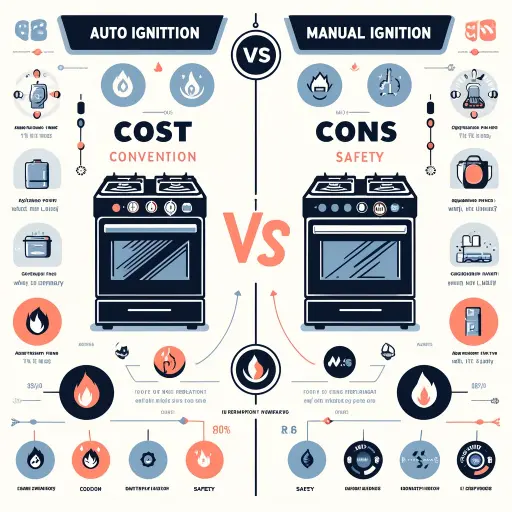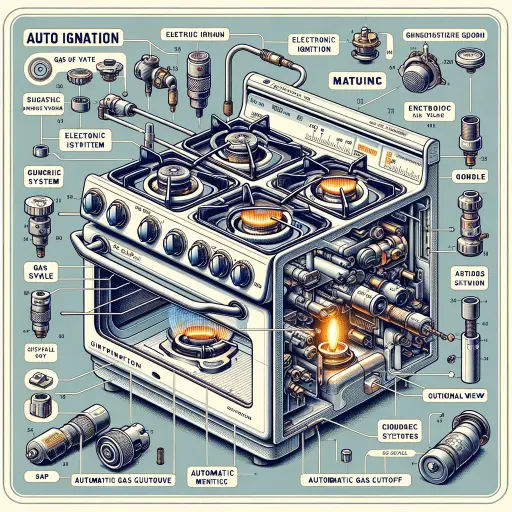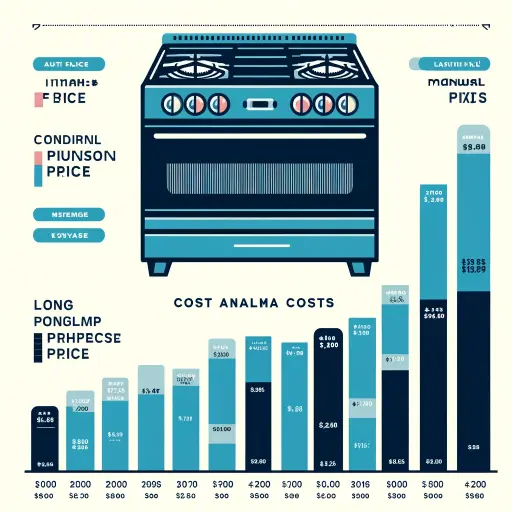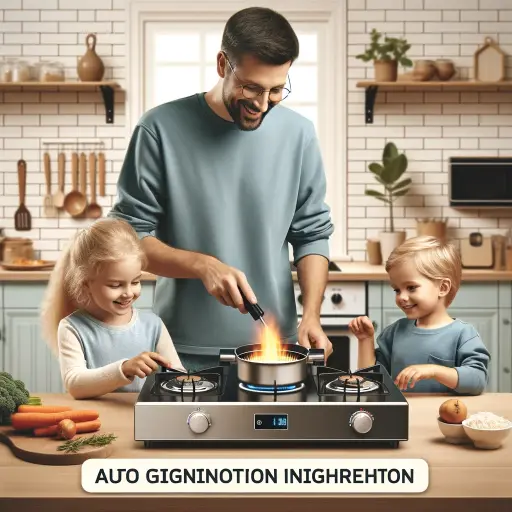Gas Stoves: Auto Ignition vs Manual Ignition
Updated: 30 Apr 2024
309
Gas stoves are essential in many kitchens, offering precise heat control. Buyers often choose between auto ignition and manual ignition models, each with unique features and operations.

Auto ignition stoves provide modern convenience, igniting with a simple turn of a knob or a button press, eliminating the need for matches. In contrast, manual ignition stoves require an external source to light, appealing to those who prefer a traditional approach.
This blog post explores the differences between auto ignition and manual ignition gas stoves. We’ll cover how each type functions, their advantages and disadvantages, and essential information to help you choose the right stove for your kitchen needs.
Manual Ignition Gas Stoves: Understanding the Basics

Manual ignition gas stoves are a classic choice in many kitchens. Unlike their auto ignition counterparts, manual ignition stoves require a separate action to ignite the gas, typically using a match or a lighter. This traditional method gives the user full control over the ignition process, making it a simple yet effective way to cook.
How to Operate a Manual Ignition Stove
Operating a manual ignition stove is straightforward but requires careful handling to ensure safety. Here’s how you can light one:
- Ensure Safety: Before igniting the stove, make sure all the knobs are in the ‘off’ position and the area is well-ventilated.
- Turn on the Gas: Rotate the gas knob of the desired burner to the ‘on’ position to release gas to the burner.
- Ignite the Burner: Immediately use a match or lighter to light the burner. Some stoves might require you to hold the ignition source near a specific part of the burner.
- Adjust the Flame: Once the burner is lit, adjust the flame according to your cooking needs by turning the knob to control the gas flow.
Pros and Cons of Using a Manual Ignition Stove
Pros:
- Cost-Effective: Manual ignition stoves are generally less expensive than auto ignition models both in upfront cost and repair expenses since they have fewer mechanical components.
- Durability: With fewer electrical parts, manual stoves are less prone to malfunctioning components, often resulting in a longer lifespan.
- Control: Provides more control over the ignition process, which can be seen as a safer option by some, as it avoids accidental ignitions.
Cons:
- Convenience: Requires an external source to ignite, which can be inconvenient and time-consuming.
- Safety Risks: There is a risk of gas buildup if the burner does not ignite immediately after the gas is turned on, which can be dangerous.
While manual ignition gas stoves may seem outdated to some, they offer reliability, cost-effectiveness, and a level of control that many experienced cooks appreciate.
Whether you are a beginner or a seasoned chef, understanding how to safely operate these stoves can enhance your cooking experience while ensuring your kitchen remains a safe environment and the gas stove does not explode.
Auto Ignition Gas Stoves: A Modern Touch to Kitchen Convenience

Auto ignition gas stoves are equipped with advanced features that allow for automatic lighting of the burners without the need for a separate ignition source. This type of stove uses either electricity or batteries to ignite the gas automatically, making it a convenient and modern addition to any kitchen.
Understanding Auto Ignition Mechanics

Auto ignition systems in gas stoves work by generating a spark when the burner knob is turned to the “on” position. This spark is created by an electric ignition system or through battery power, depending on the stove’s design. Here’s how it typically works:
- Turn the Knob: Simply turn the knob to the ignite position.
- Automatic Ignition: The system automatically produces a spark that ignites the gas.
- Adjust the Flame: Once lit, adjust the flame to your desired level for cooking.
This seamless process eliminates the need for matches or lighters, offering a straightforward and efficient way to start cooking.
Types of Auto Ignition Systems
Auto ignition stoves can vary based on their ignition source:
- Electric Ignition: These systems use the home’s electricity to generate a spark. They are common in many modern kitchens.
- Battery-Operated Ignition: These stoves use batteries to create the ignition spark, which can be beneficial in areas with frequent power outages.
Pros and Cons of Using an Auto Ignition Stove
Pros:
- Convenience: Auto ignition stoves provide immediate flame with minimal effort, enhancing cooking efficiency.
- Safety: These stoves typically include safety features that prevent gas leaks by cutting off the gas if the flame goes out unexpectedly.
- Modern Features: Often come with advanced controls and features that enhance cooking precision and flexibility.
Cons:
- Cost: Generally more expensive than manual ignition stoves, both in initial investment and potential repair costs.
- Maintenance: Depending on the type of ignition, these stoves can require more maintenance, especially if components like electric igniters or batteries need replacement.
- Dependence on Power: Electric models require a continuous power supply, which can be a drawback during power outages (unless battery backup options are available).
Auto ignition gas stoves blend advanced technology with exceptional convenience, making them a popular choice for modern homes.
They simplify the cooking process by eliminating the need for manual ignition and often include safety features that make them safer and more reliable than traditional models. While they may come with higher upfront and maintenance costs, the benefits of ease and enhanced safety can be significant.
Comparing Auto Ignition and Manual Ignition Gas Stoves
Quick Comparison Table – Auto Ignition vs Manual Ignition Gas Stoves
| Feature | Auto Ignition Stove | Manual Ignition Stove |
|---|---|---|
| Ignition Method | Automatic, with a push of a button or turn of a knob | Requires a manual source like a match or lighter |
| Convenience | High, instant ignition | Lower, requires additional steps |
| Installation | Needs electricity or batteries | Does not require electricity or batteries |
| Initial Cost | Higher due to complex components | Lower, simpler technology |
| Maintenance Cost | Potentially higher, electronic parts may need maintenance | Generally lower, fewer components to fail |
| Safety Features | Often includes safety shut-offs and child locks | Typically fewer built-in safety features |
| Energy Use | Uses a small amount of electricity or battery power | Only uses gas, no additional energy for ignition |
| Reliability | Dependent on electrical components | More reliable in areas with frequent power outages |
| Suitability | Preferred in modern homes, busy families, and where convenience is a priority | Preferred where simplicity and budget are priorities, and in areas with unstable power supply |
Detailed Comparison

When choosing a gas stove, the decision between auto ignition and manual ignition can significantly impact your kitchen’s efficiency, safety, and usability. Here’s a detailed comparison to help you understand the differences and make an informed choice.
Side-by-Side Comparison
Auto Ignition Stoves:
- Operation: Ignites automatically when the knob is turned, using electricity or batteries.
- Cost: Generally higher initial cost and potential repair costs.
- Maintenance: Requires more frequent maintenance for electronic components.
- Safety Features: Often includes automatic shut-off features and child safety locks.
Manual Ignition Stoves:
- Operation: Requires a separate action with a match or lighter to ignite the gas.
- Cost: Lower initial cost and typically lower maintenance expenses.
- Maintenance: Less complex, with fewer components that could fail.
- Safety Features: Fewer built-in safety features, reliant on user operation for safety.
Situational Preferences
Households with Elderly or Children:
Auto ignition stoves are generally safer and easier for elderly individuals who may struggle with the physical action required for manual stoves. The safety features like auto shut-off and child locks also make them preferable in households with children.
Professional Kitchens:
In a high-paced environment like a professional kitchen, the convenience and quick operation of auto ignition stoves can improve efficiency. However, the reliability and control offered by manual ignition stoves may be preferred by some chefs.
Energy Efficiency and Consumption
While both types of stoves use gas as their primary energy source, the efficiency can differ slightly:
- Auto Ignition: May use a small amount of electricity or battery power, adding a minimal cost to overall energy consumption. However, the precise control can lead to better energy management.
- Manual Ignition: Uses only the gas required for cooking, with no additional energy for operation, which might be seen as more energy-efficient in a straightforward sense.
Reliability and Performance Under Different Conditions
Auto Ignition:
- Reliability: Can be affected by electrical issues or battery life. In the event of power failures, stoves that rely on electricity might not function unless they have a battery backup.
- Performance: Offers consistent and quick ignition under most conditions.
Manual Ignition:
- Reliability: Generally more reliable as it is not dependent on electricity or batteries. It performs consistently regardless of power availability.
- Performance: Performance is stable, but the requirement for manual ignition can be a disadvantage in rapid cooking situations.
Market Trends and Consumer Preferences
When deciding between an auto ignition and a manual ignition gas stove, it’s essential to consider the evolving trends in kitchen appliance preferences and the technological advancements that shape these trends.
Over the past decade, there has been a significant shift towards auto ignition stoves, primarily due to the growing demand for convenience and safety in kitchen appliances.
Auto ignition stoves have gained popularity because they eliminate the need for matches or lighters, which enhances safety and convenience. This feature is particularly appealing in households with young children or elderly individuals where safety concerns are paramount.

Additionally, the integration of advanced safety features like automatic shut-offs to prevent gas leaks has made auto ignition stoves even more desirable.
However, manual ignition stoves continue to hold a significant market share, especially in regions where reliability and cost are critical factors. These stoves are preferred in areas with frequent power outages, as they do not rely on electricity or batteries to operate.
The lower initial cost and reduced maintenance expenses also make manual ignition stoves a budget-friendly option for many consumers.
Factors to Consider When Choosing Between Auto and Manual Ignition Gas Stoves
Selecting the right gas stove, whether auto ignition or manual, involves considering several factors that align with your personal needs, kitchen setup, and lifestyle. Understanding these factors can help you make a choice that offers the best combination of functionality, safety, and value.
User’s Lifestyle and Kitchen Habits

Cooking Frequency and Style:
- Auto Ignition: Ideal for those who cook frequently and value convenience and quick operation. It’s particularly useful for busy families or individuals who need to prepare meals quickly.
- Manual Ignition: Suitable for those who may not mind the extra step of using a match or lighter and perhaps enjoy a more hands-on approach to cooking.
Installation Requirements and Compatibility with Home Infrastructure
Power Availability:
- Auto Ignition: Requires electricity or batteries to operate. Ensure that your kitchen is equipped with power outlets near the stove area, or be prepared to regularly change batteries.
- Manual Ignition: Does not require any electrical power, making it a good choice for areas prone to power outages or where electrical services are unreliable.
Budget and Long-term Cost Implications
Initial Investment and Maintenance Costs:
- Auto Ignition: Generally more expensive initially and may incur higher maintenance costs over time, especially if electronic components need repairs.
- Manual Ignition: More budget-friendly with lower initial costs and typically less expensive long-term maintenance.
Safety Features and Certifications

Built-in Safety Mechanisms:
- Auto Ignition: Often comes with advanced safety features such as automatic gas shut-off if the flame goes out, and child lock features, making it a safer option overall.
- Manual Ignition: Less likely to have advanced safety features, requiring careful handling to ensure safety during use. Users need to be vigilant about turning off the gas when not in use to prevent leaks.
Certifications:
Ensure whichever model you choose has relevant safety certifications that comply with national or international safety standards, providing an extra layer of security and peace of mind.
Warranty and Support
Manufacturer’s Warranty:
- Auto Ignition: Check if the warranty covers electronic components and for how long, as these can be costly to replace.
- Manual Ignition: Warranty may be less of a concern due to the simplicity of the design, but it’s still important to have good coverage for peace of mind.
Conclusion
In conclusion, choosing between auto and manual ignition gas stoves depends on balancing factors like convenience, safety, cost, and personal needs. Auto ignition stoves are ideal for modern households that value ease of use and safety, particularly suitable for families with children or elderly members.
Conversely, manual ignition stoves appeal for their cost-effectiveness and reliability, especially in areas with frequent power outages. Ultimately, the decision should align with your cooking habits and kitchen setup, weighing each type’s benefits to select the stove that best meets your requirements.
Please Write Your Comments